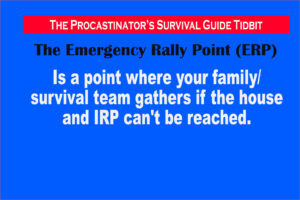Survival 5: Levels of Emergencies to Prepare for and Important Survival Definitions

DEFINITIONS
There are so many variables when we
consider the possible disasters, emergencies, accidents, etcetera that we could
face both on a day to day basis and long term. To ensure we’re on the same
page, let’s agree on some definitions.
Three
Levels of Emergencies.
I’m going to define three types of
survival situations/emergencies and will use these definitions throughout the
book. They are also the order of what is most likely to happen. Our immediate
goal is be prepared for a mild emergency. As we go through we can just focus on
mild initially, and then come back to the higher levels; when we’re done
procrastinating.
Mild: We
experience some discomfort from our normal routine for no more than 48 hours,
but it is not life threatening. Example: Our power goes off for a day or two.
Moderate: We
experience a large change from our normal routine, either natural or man-made,
which is not immediately life threatening but has the potential to become so if
not dealt with, and/or it continues. Example: Our power goes off for five days
or more. Our car slides off the road in a remote area and you are trapped
inside. A powerful hurricane is approaching. A large earthquake strikes.
Extreme: A
catastrophic natural or man-made event that immediately threatens our life and
the lives of all around us, and if it continues, will be a constant threat.
Example: A tsunami hits our coastal town. A tornado destroys our home. Nuclear,
biological and chemical accident or warfare or terrorist attack. A powerful
earthquake. The collapse of civilization. A pandemic with a high transmission
and kill rate, aka zombies. Assume the worst until the situation stabilizes.
Length
of emergency depends on how widespread it is, how severe, and how long it takes
society to recover, if at all. There are too many variables to make any definitive
parameters.
Some
extreme emergencies could be very short in duration. For example a severe car
crash. A mild emergency that continues, might have a severe, long-term effect,
such as a drought that doesn’t abate. There could be a slow economic failure
that will take years. A mild emergency for one person could be extreme for
someone else—for example a hornet sting is painful and irritating for one
person but life-threatening for someone who has an adverse reaction. That is
why the Area Study which we’ll do is so important.
As
you will see in the Area Study, I make a split and give a Mild Level of
preparation and then a Moderate/Extreme (Mod/Ex) level. Initially, focus on
being prepared for Mild. Then move to Mod/Ex in the priority determined by your
Area Study. Mod/Ex is when you are moving from common emergencies that we all
endure (such as a power outage) to something where you will probably have to
evacuate your home for an indeterminate period of time. The former will
certainly happen; the latter is one that is only a possibility we hope never
occurs to us.
AREA OF OPERATIONS refers to the area around you. This
includes your home, work, and school. It expands or contracts depending on the
circumstances.
A-TEAM
refers to the people you will be with during an emergency/disaster. For many of
us that naturally means our family. For others, it could be a group of people
we’ve coordinated with beforehand (more on that shortly). In an emergency it
could also be the people we’re trapped with. I use this term instead of
constantly referring to family/team.
IRP stands
for Immediate Rally Point. This is a point outside of your home where your
family can gather if they have to evacuate the house for some reason. The most
likely reason for this would be if there was a fire. It needs to be a place
that’s easily identifiable and not far from the house and everyone can find in
the dark.
It’s also the place where your A-Team
will rendezvous if they can’t go into the house for whatever reason, but need
to assemble from other locations, such as school and/or work.
A street intersection near the home
works well. Or a neighbor’s home.
ERP stands
for Emergency Rally Point. It is where everyone will assemble if they can’t get
to the IRP or home. This is also where your A-Team will rendezvous if they have
to evacuate the home/work/school during a moderate or extreme emergency and
have to stay for at least a day or more, with the possibility of not returning
to the home.
BOHS
stands for Bug Out Hide Site and is only for extreme emergencies where you’ve
left your home and don’t plan on coming back. It refers to being on the move
and also wherever you may stop, either temporarily or permanently, depending on
the extent of the emergency and threats.
GnG stands for Grab-n-Go bag.
The Procrastinator’s Survival Guide



